Bitlayer is about to issue a coin: a scythe of harvest or the dawn of BTCFi?
On August 26, YZi Labs announced a strategic investment in USD.AI, a stablecoin protocol that enables AI infrastructure projects to access hardware-collateralized financing.
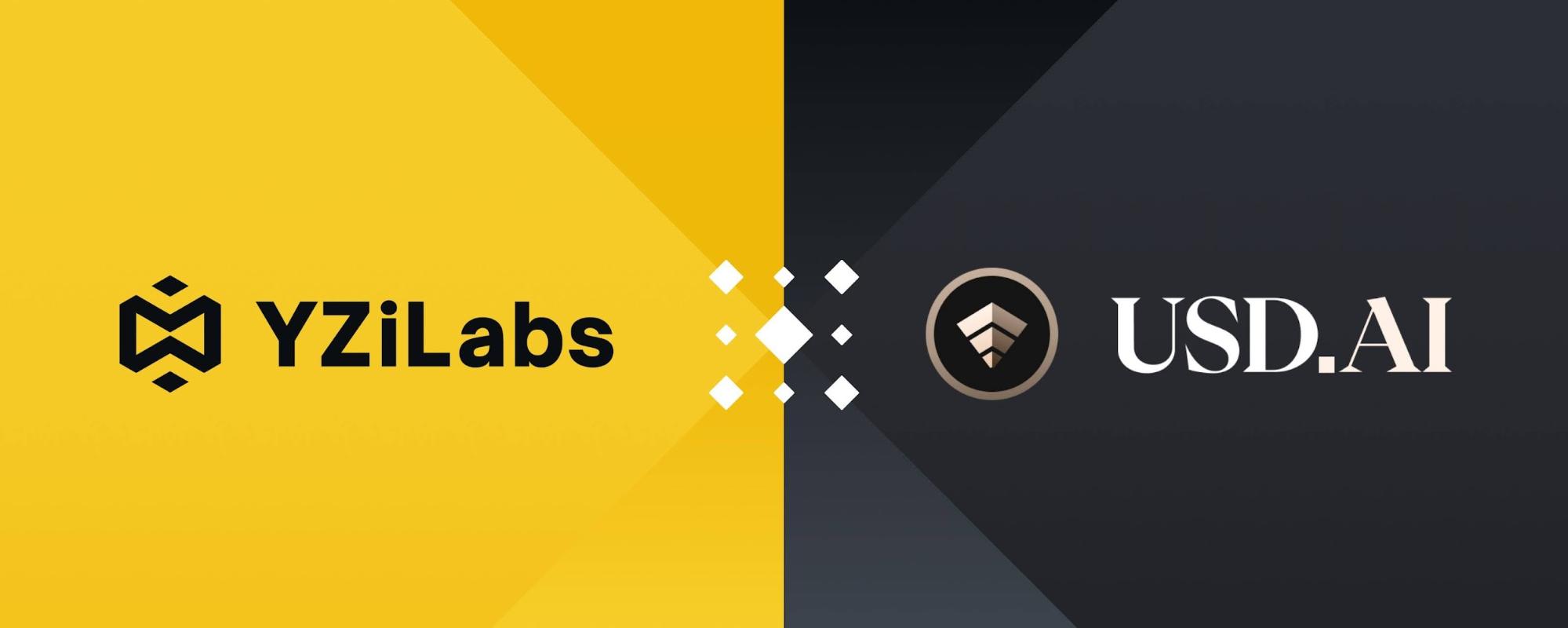
Data from Coingecko shows that global stablecoin market capitalization has surpassed $285 billion. Meanwhile, major players like Circle and Kraken are rapidly moving into the stablecoin payments sector.
Despite this growth, most existing stablecoin projects remain anchored to conventional models, such as pegging to the US dollar or US Treasury bonds, with little genuine innovation and a prevailing lack of imagination. Against this landscape, a standout challenger is entering the market with a fresh approach.
Recently, USD.AI—a stablecoin project uniquely blending DePIN, RWA, and AI—has sparked strong market debate. Rather than simply pegging to the dollar, it generates returns by collateralizing AI hardware, bridging the financing gap for computational resources.
With its official launch and deposit portal now open, USD.AI has rapidly gained attention, potentially ushering in new opportunities at the intersection of AI and stablecoins.
Project Background
Rootdata indicates the project was launched in 2024. Among its leadership, USD.AI co-founder David Choi is also the co-founder and CEO of MetaStreet, a well-known NFT lending platform, and was previously an investment banking analyst at Deutsche Bank.
USD.AI’s high-profile fundraising is what truly brought the project into the spotlight.
On the 14th of this month, USD.AI announced it had completed a $13.4 million Series A funding round led by Framework Ventures.
Framework Ventures—an investment firm specializing in DeFi and infrastructure—has previously backed industry leaders like Uniswap and Chainlink. By leading this round, Framework Ventures signals strong institutional confidence in USD.AI’s innovative approach. The investor lineup also includes top crypto VC firm Dragonfly, Layer 2 leader Arbitrum, and the recently public exchange Bullish, among others.

This powerhouse roster not only brings substantial resources to USD.AI but also underscores how DePIN+AI stablecoin projects are attracting leading capital, sending market expectations higher. Following the investment announcement, the USD.AI team doubled down and launched the project on the 19th, igniting broad market discussion.
How It Works and Core Mechanisms
As demand for AI computing grows, USD.AI is designed to merge stablecoin protocols with AI infrastructure financing—addressing challenges few others have tackled:
Many small and mid-size AI companies own valuable GPU hardware, but cannot easily secure working capital through traditional finance.
The project’s core mission is to leverage on-chain capital to fund AI companies’ hardware procurement and operations, filling a gap that traditional finance has left in the new AI-driven economy—all while maintaining the low-risk profile expected of stablecoins.
USD.AI’s “collateral-mint-invest-yield” closed-loop system integrates trending concepts like RWA and AI, positioning it as a uniquely innovative player in the current stablecoin wave.
Here’s how it works: users deposit stablecoins such as USDT or USDC as collateral, minting USDai at a 1:1 ratio. USDai is backed by US Treasuries and blue-chip stablecoins, maintaining a dollar peg along with instant redemption and liquidity—making it ideal for DeFi trading or liquidity provision. Users can stake USDai to obtain sUSDai tokens, which can be used to earn extra yield via other DeFi protocols—a “one token, multiple streams” strategy.
USD.AI allocates deposits in two primary ways: First, it issues loans to AI companies for GPU and related hardware purchases, generating significant interest (annualized returns currently listed at 6.96%). Second, idle funds are invested in US Treasuries, providing a stable baseline return. sUSDai holders can leverage DeFi protocols to amplify yield, with the website quoting target annualized returns of 15%-25%. USDai holders, meanwhile, benefit from lower-risk but stable yields.
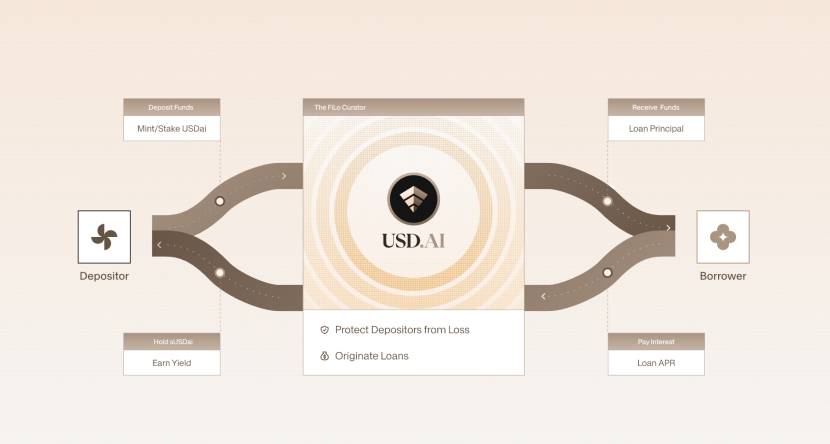
USD.AI’s core mechanisms include several innovative features to support stability and openness:
1. Dual-token structure: USDai, designed as a low-risk stablecoin for risk-averse users; and sUSDai, tailored for those seeking higher returns and willing to take on greater risk. This dual model appeals to a range of risk appetites while ensuring DeFi ecosystem compatibility.
2. Asset tokenization and CALIBER framework: Leveraging the CALIBER framework, USD.AI tokenizes physical assets like AI hardware into on-chain assets, using legal and technical safeguards to guarantee transparent, enforceable asset ownership. An on-chain insurance module further reduces default risk.
3. QEV redemption mechanism: To solve for the longer duration and lower liquidity of AI infrastructure assets, USD.AI’s QEV model uses market-driven processes to manage sUSDai redemption, avoiding “first come, first served” bottlenecks and ensuring fairness and protocol stability.
4. FiLo Curator expansion: This mechanism allows USD.AI to onboard a wide range of new borrowers and dramatically expand its AI hardware portfolio. Built-in structural protections and risk-alignment features help protect user interests and ensure a diverse, sustainable revenue base.
In summary, user deposits are used to fund interest-bearing loans to AI companies seeking GPU compute power, and the entire process is fully transparent. Idle capital is invested in US Treasuries for a guaranteed minimum return.
USD.AI’s unique design delivers robust competitive advantages: it pursues higher yield through AI infrastructure investment compared to typical stablecoins, and its risk-segregation and insurance features sharply reduce systemic risk compared to many high-risk DeFi protocols.
As such, USD.AI injects fresh energy into the stablecoin market while also delivering a scalable new solution for the capital needs of the AI sector—potentially establishing itself as a pioneer at the convergence of stablecoins and AI infrastructure.
How to Participate
USD.AI currently accepts user deposits and allows participants to invite others to earn Allo points in its rewards system.
Token rewards can be earned through either an ICO or an airdrop. All participants are subject to a $30 million circulating supply valuation (representing 10% of the project’s $300 million FDV).
According to USD.AI’s official posts, minting or staking USDai will continuously generate points each day. Users can choose different strategies to determine whether they secure an ICO allocation or an airdrop reward.
The Allo points campaign will end once YPO (cumulative paid-out yield) hits $20 million. Those wishing to participate in the ICO need to complete KYC. Airdrop participants do not require KYC.
For advanced strategies to earn Allo points, refer to the official post and accompanying video.
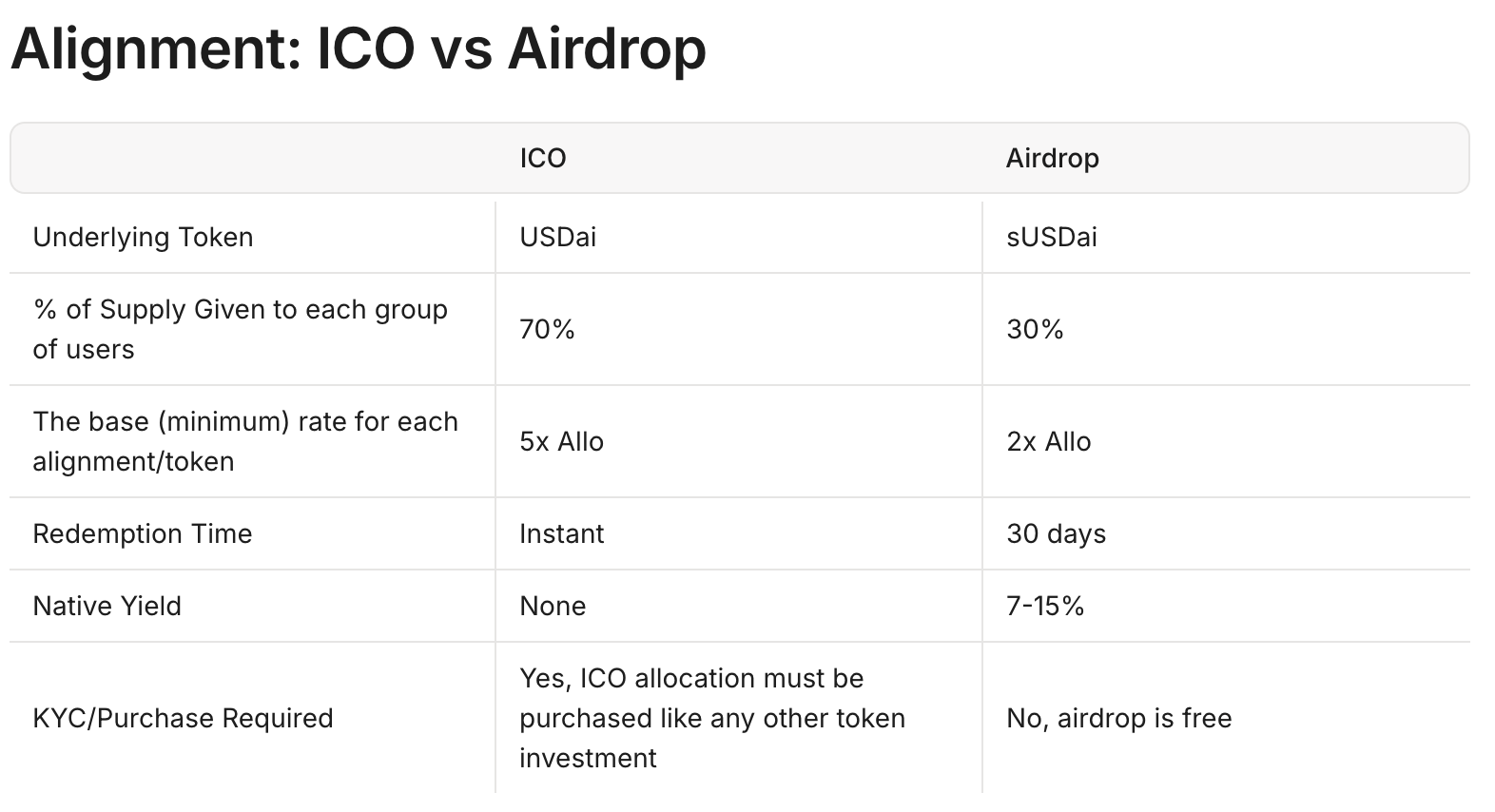
In short, holding USDai qualifies you for the ICO. To join the airdrop, you must stake USDai to receive sUSDai.
Any current purchases of USDai or sUSDai will receive qUSDai—a deposit queue voucher—which will be automatically converted into the corresponding tokens within 24 hours.
USD.AI’s total deposit limit is $100 million. Since all new deposits are still in qUSDai status, the current TVL reflects only the $52 million deposited during the closed beta test.

Market Perspectives
Market sentiment around USD.AI is sharply divided.
Supporters see USD.AI as an innovative stablecoin project that captures the current AI boom, allowing participants to earn stable returns while benefiting from the potential growth of AI. It offers multiple participation strategies, appealing to both conservative and risk-oriented users by combining typical stablecoin stability with opportunities for higher returns.

On the other hand, critics argue that information disclosures suggest a predominantly Chinese team and accuse the project of merely stringing together popular industry buzzwords without real innovation.
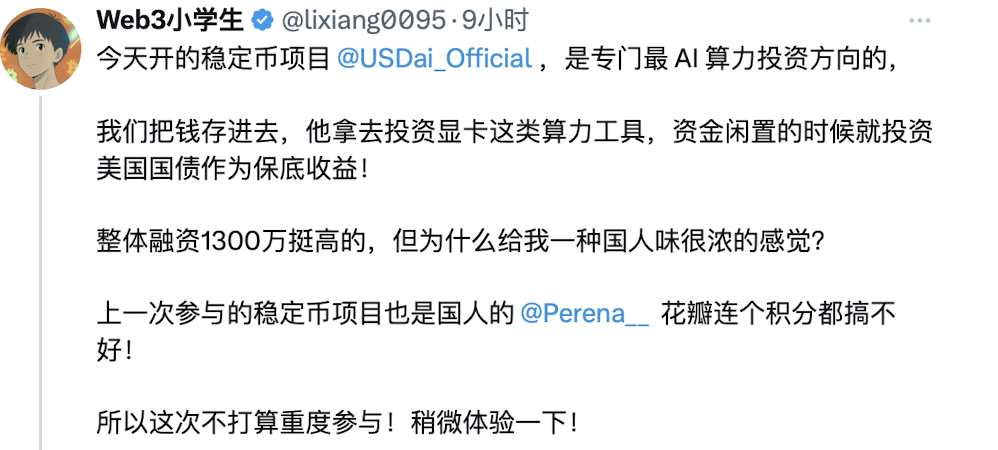
Interestingly, USD.AI co-founder David directly replied to this “FUD” post, clarifying that he is Korean-American and that the project is headquartered in New York, while also welcoming questions from Chinese-speaking users.
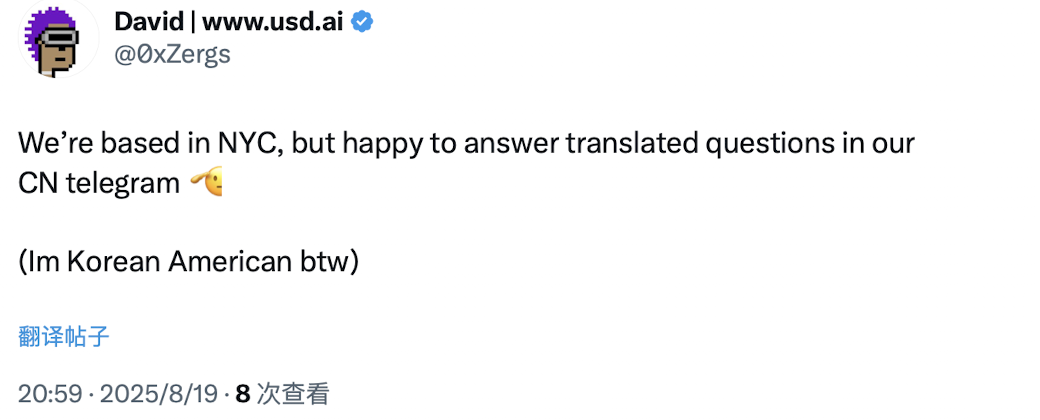
In the author’s opinion, USD.AI brings a new answer to the increasingly competitive stablecoin landscape. Whether it ultimately gains market recognition depends on user adoption and whether the project reaches its $100 million TVL cap.
Its fate will serve as a litmus test for the market’s acceptance of this new “AI infrastructure + stablecoin” narrative.
Disclaimer:
- This article is reposted from [TechFlow], with copyright held by the original author [伞,深潮 TechFlow]. For any concerns regarding the repost, please contact the Gate Learn team for prompt resolution in accordance with relevant procedures.
- Disclaimer: The views and opinions expressed herein are solely those of the author and do not constitute investment advice of any kind.
- Other language versions of this article are translated by the Gate Learn team. No part of the translated article may be copied, distributed, or plagiarized without reference to Gate where not otherwise specified.
Related Articles

In-depth Explanation of Yala: Building a Modular DeFi Yield Aggregator with $YU Stablecoin as a Medium

What is Stablecoin?

Top 15 Stablecoins

A Complete Overview of Stablecoin Yield Strategies

What Is USDT0
